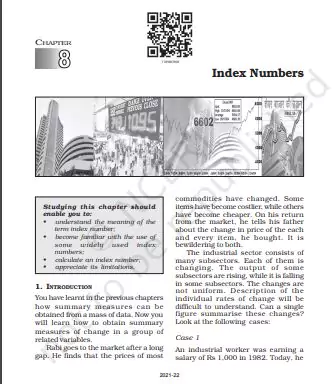‘NCERT Solutions for Class 11 Statistics Chapter 8 Organisation of Data‘ PDF Quick download link is given at the bottom of this article. You can see the PDF demo, size of the PDF, page numbers, and direct download Free PDF of ‘Ncert Class 11 Statistics Chapter 8 Exercise Solution’ using the download button.
Index Numbers Book PDF Free Download

Chapter 8: Index Numbers
You have learnt in the previous chapters how summary measures can be obtained from a mass of data. Now you will learn how to obtain summary measures of change in a group of related variables. Rabi goes to the market after a long gap. He finds that the prices of most commodities have changed. Some items have become costlier, while others have become cheaper. On his return from the market, he tells his father about the change in price of the each and every item, he bought. It is bewildering to both.
The industrial sector consists of many subsectors. Each of them is changing. The output of some subsectors are rising, while it is falling in some subsectors. The changes are not uniform. Description of the individual rates of change will be difficult to understand.
Can a single figure summarise these changes? Look at the following cases: Case 1 An industrial worker was earning a salary of Rs 1,000 in 1982. Today, he earns Rs 12,000.
Can his standard of living be said to have risen 12 times during this period? By how much should his salary be raised so that he is as well off as before? Case 2 You must be reading about the Sensex in the newspapers. The Sensex crossing 8000 points is, indeed, greeted with euphoria. When Sensex dipped 600 points recently, it eroded investors’ wealth by Rs 1,53,690 crores.
What exactly is Sensex? Case 3 The government says the inflation rate will not accelerate due to the rise in the price of petroleum products. How does one measure inflation? These are a sample of questions you confront in your daily life. A study of the index number helps in analyzing these questions.
WHAT IS AN INDEX NUMBER
An index number is a statistical device for measuring changes in the magnitude of a group of related variables. It represents the general trend of diverging ratios, from which it is calculated. It is a measure of the average change in a group of related variables over two different situations. The comparison may be between like categories such as persons, schools, hospitals etc.
An index number also measures changes in the value of the variables such as prices of a specified list of commodities, the volume of production in different sectors of industry, production of various agricultural crops, cost of living etc.
Conventionally, index numbers are expressed in terms of percentage. Of the two periods, the period with which the comparison is to be made, is known as the base period. The value in the base period is given the index number 100.
If you want to know how much the price has changed in 2005 from the level in 1990, then 1990 becomes the base. The index number of any period is in proportion with it. Thus an index number of 250 indicates that the value is two and half times that of the base period.
Price index numbers measure and permit comparison of the prices of certain goods. Quantity index numbers measure the changes in the physical volume of production, construction or employment. Though price index numbers are more widely used, a production index is also an important indicator of the level of output in the economy.
| Author | NCERT |
| Language | English |
| No. of Pages | 15 |
| PDF Size | 1.8 MB |
| Category | Statistics |
| Source/Credits | ncert.nic.in |
NCERT Solutions Class 11 Statistics Chapter 8 Index Numbers
Question 1.
An index number that accounts for the relative importance of the items is known as
(i) weighted index
(ii) simple aggregative index
(iii) simple average of relatives
Answer:
(i) An index number becomes a weighted index when the relative importance of items is taken care of weighted index is the weighted average of different goods.
Question 2.
In most of the weighted index numbers the weight pertains to
(i) base year
(ii) current year
(iii) both base and current year
Answer:
(i) In general, the base period weight is preferred in calculating the weighted index number but as per Laspeyre’s method it uses the base year quantity as weight, Paache uses current year quantities as weight and Fisher’s Index Method uses both base and current year quantities.
Question 3.
The impact of change in the price of a commodity with little weight in the index will be
(i) small
(ii) large
(iii) uncertain
Answer:
(i) An equal rise in the price of an item with little weight will have lower implications for the overall change in the price ;ndex than that of an Item with more weight.
NCERT Class 11 Statistics Textbook Chapter 8 With Answer PDF Free Download
